    
Rzebitschek 17598-1540

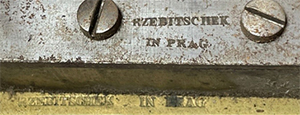
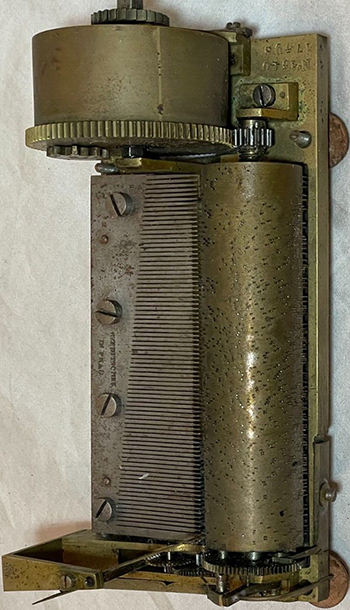
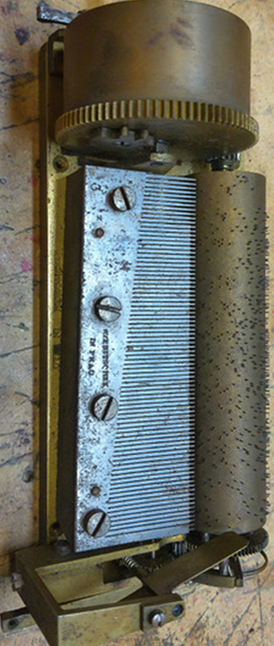
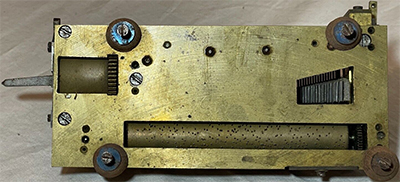
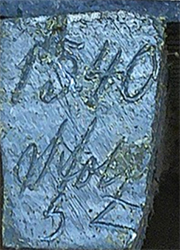


The comb has 81 teeth, and the cylinder is 9.9 cm in length and 2.3 cm in diameter
S/N 38768: I note that the names of the two pieces are not given on your website. They are (1) Johann Strauss, Sr., Radetzky March and (2) Duet "A consolarmi affrettisi" from Act I of Gaetano Donizetti's Linda di Chamounix (the same titles could be added to s/n 38381). This mechanism was installed upside down in a box much too large for it, so I made a new box for it as part of my process of restoring the movement. I think I sent some pictures in my message of 18 January, along with the titles of the pieces.
S/N 38858: Somehow or other, the titles of the tunes for 38768 have gotten into the description for this mechanism (https://eiou.at/prager/rz/30000/38858-3503/38858-3503.html). The titles of the tunes on 38858 are (1) Luigi Arditi, "Il Bacio" and (2) "Miserere" from Act IV of Giuseppe Verdi's Il Trovatore. I notice you have also included my Youtube link as well, but this is erroneous: the link is a recording of 38768.
S/N 39108: The title on your website is still given as Meister Fortunie, which is an incorrect transcription of the tune sheet; I have this box, and the tune sheet clearly reads Meister Fortunio, the German title for Jacques Offenbach's La Chanson de Fortunio. Whoever previously transcribed it for you was misled by bits of dirt over the final letter that make it look somewhat like an "e."
S/N 42110: The website description still gives this as a 2-tune mechanism, but it (like its parallel s/n 45851) is a 3-tune mechanism. When I sent you the names of the second and third tunes a little over a year ago, I had not been able to identify the first tune, but I have finally succeeded in doing so. It is the Act IV Cavatina from Robert le diable by Giacomo Meyerbeer. So, the complete list for this mechanism should be: (1) Cavatina "Robert, toi que j'aime" from Act IV of Giacomo Meyerbeer's Robert le diable (1831), (2) "Amis, la matinée est belle" from Act II of D.-F.-E. Auber's La Muette de Portici (1828), and (3) "O sommo Carlo" from the Act III finale of Giuseppe Verdi's Ernani (1844). Since s/n 45851 shares the same music number, I assume these are also the tunes on that mechanism. I'm not sure why you have the comb as marked "Gustav Rebicek" (perhaps because I hypothesized that the mechanism might have been manufactured by Gustav?); the comb is clearly marked "F. Rzebitschek," as your pictures show.
And one final observation that may be of interest. In the course of restoring six Rzebitschek mechanisms and two Olbrichs, all of which have more or less the same size cylinder, I noticed that the length of the governor fan varied from 3.9 cm to 5 cm (which of course affects the duration of the tunes) and a variation in length occurs as well in the governor cock and base, with the horizontal extension of the cock at 2.5 cm or 3 cm. This surprised me because I (erroneously) assumed that since these movements are so consistent in their dimensions and construction, all the parts--including the governor bases, cocks, and fans--would have been made in a stock size and then the fan trimmed by the finisher to the length that set the best tempo for the tunes. My sample is too small for any solid conclusion to be drawn, but it now seems that at least the basic tempo of the tunes (faster or slower) must have been calculated from the beginning stages of construction of the mechanism and the governor bases and cocks were manufactured in at least two sizes to match shorter or longer governor fans. If this is so, I think this would be yet another unique feature of these Rzebitschek movements. I have not noticed this characteristic among individual Swiss manufacturers, but they would have had no need of it inasmuch as their fans were adjustable, and stock sizes for the governors would not have impeded considerable variations in tempo.
I hope some of this information will be helpful for your website and of interest to you and others.
Fotografie: ©Archiv Otmara Seemanna
    
|